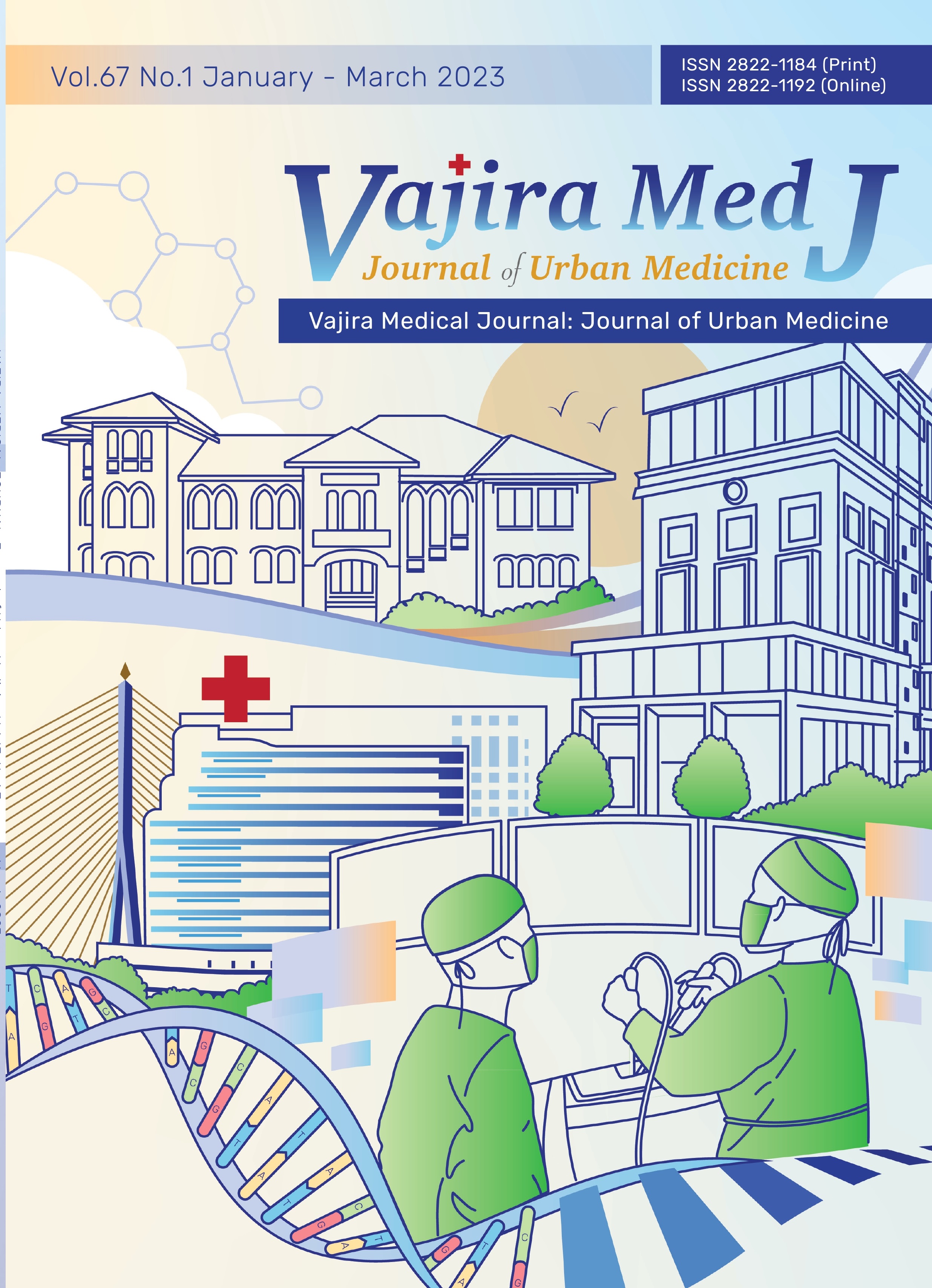Rate and Predictors of Postoperative Respiratory Complications Following Adenotonsillectomy in Children with Obstructive Sleep Apnea Predicting Postoperative Respiratory Complications
Main Article Content
Abstract
OBJECTIVE: This study aimed to determine the rate and risk factors of postoperative respiratory complications in children with obstructive sleep apnea (OSA) who underwent adenotonsillectomy.
METHODS: A retrospective study was conducted on the date of children with OSA who underwent adenotonsillectomy between April 2013 and July 2021. Data on demographics, medical history, tonsil grading, polysomnography parameters, and postoperative respiratory complications including cough, position, airway intervention, and desaturation were collected. Chi-square test or Fisher’s exact test was performed to evaluate risk factors.
RESULTS: Seventy-one children with OSA who underwent adenotonsillectomy were included in this study. The overall rate of postoperative respiratory complications was 32/71 (45.1%) and that of minor respiratory complications was 37/52 (71.2%), including desaturation, supplement oxygen, reposition, and cough. Statistically significant association with postoperative respiratory complications was observed for obese versus non-obese (p < 0.001), severe apnea–hypopnea index (AHI) (p = 0.001), and severe lowest oxygen saturation (p = 0.001).
CONCLUSION: Despite the high rate of minor respiratory complications, postoperative respiratory complications are frequent after adenotonsillectomy among children with OSA. Obese versus non-obese and severity of AHI and lowest oxygen saturation are associated with postoperative respiratory complications following adenotonsillectomy.
Downloads
Article Details

This work is licensed under a Creative Commons Attribution-NonCommercial-NoDerivatives 4.0 International License.
References
Lumeng JC, Chervin RD. Epidemiology of pediatric obstructive sleep apnea. Proc Am Thorac Soc 2008;5(2):242-52.
Marcus CL, Brooks LJ, Draper KA, Gozal D, Halbower AC, Jones J, et al. Diagnosis and management of childhood obstructive sleep apnea syndrome. Pediatrics 2012;130(3):e714-55.
Keamy DG, Chhabra KR, Hartnick CJ. Predictors of complications following adenotonsillectomy in children with severe obstructive sleep apnea. Int J Pediatr Otorhinolaryngol 2015;79(11):1838-41.
Saur JS, Brietzke SE. Polysomnography results versus clinical factors to predict post-operative respiratory complications following pediatricVajira Med J 2023; 67(1) Jan-Mar: 448-454 453 Israsena Na Ayudhya W and Rojanawong W a d e n ot o n s i l l e c t o m y. I nt J P e d i at r Otorhinolaryngol 2017;98:136-42.
Brigger MT, Brietzke SE. Outpatient tonsillectomy in children: a systematic review. Otolaryngol Head Neck Surg 2006;135(1):1-7.
Pratt LW, Gallagher RA. Tonsillectomy and adenoidectomy: incidence and mortality, 1968-1972. Otolaryngol Head Neck Surg (1979) 1979;87(2):159-66.
McColley SA, April MM, Carroll JL, Naclerio RM, Loughlin GM. Respiratory compromise after adenotonsillectomy in children with obstructive sleep apnea. Arch Otolaryngol Head Neck Surg 1992;118(9):940-3.
Thongyam A, Marcus CL, Lockman JL, Cornaglia MA, Caroff A, Gallagher PR, et al. Predictors of perioperative complications in higher risk children after adenotonsillectomy for obstructive sleep apnea: a prospective study. Otolaryngol Head Neck Surg 2014;151(6):1046-54.
Mitchell RB, Archer SM, Ishman SL, Rosenfeld RM, Coles S, Finestone SA, et al. Clinical practice guideline: tonsillectomy in children (update). Otolaryngol Head Neck Surg 2019;160(1 suppl):S1-42.
Practice guidelines for the perioperative management of patients with obstructive sleep apnea: an updated report by the American Society of Anesthesiologists task force on perioperative management of patients with obstructive sleep apnea. Anesthesiology 2014;120(2):268-86.
Katz ES, Marcus CL. Diagnosis of obstructive sleep apnea syndrome in infant and children. Principles and practice of pediatric sleep medicine. Philadelphia: Elsevier Saunders; 2005. p.197-210.
Salepun S, Srisura W, Sukjai S, Kongkajun S, Ladwilai N. Know your weight and height [Internet]. 2020 [cited 2022 Feb 18]. Available from: https://nutrition2.anamai.moph.go.th
Berry RB, Budhiraja R, Gottlieb DJ, Gozal D, Iber C, Kapur VK, et al. Rules for scoring respiratory events in sleep: update of the 2007 AASM manual for the scoring of sleep and associated events. Deliberations of the sleep apnea definitions task force of the American Academy of Sleep Medicine. J Clin Sleep Med 2012;8(5):597-619.
Rossi NA, Spaude J, Ohlstein JF, Pine HS, Daram S, McKinnon BJ, et al. Apnea-hypopnea index severity as an independent predictor of post-tonsillectomy respiratory complications in pediatric patients: a retrospective study. Ear Nose Throat J 2021:1455613211059468.
Caetta A, Timashpolsky A, Tominaga SM, D'Souza N, Goldstein NA. Postoperative respiratory complications after adenotonsillectomy in children with obstructive sleep apnea. Int J Pediatr Otorhinolaryngol 2021;148:110835.
Fung E, Cave D, Witmans M, Gan K, El-Hakim H. Postoperative respiratory complications and recovery in obese children following adenotonsillectomy for sleep-disordered breathing: a case-control study. Otolaryngol Head Neck Surg 2010;142(6):898-905.
Hill CA, Litvak A, Canapari C, Cummings B, Collins C, Keamy DG, et al. A pilot study to identify pre- and peri-operative risk factors for airway complications following adenotonsillectomy for treatment of severe pediatric OSA. Int J Pediatr Otorhinolaryngol 2011;75(11):1385-90.
Katz SL, Monsour A, Barrowman N, Hoey L, Bromwich M, Momoli F, et al. Predictors of postoperative respiratory complications in children undergoing adenotonsillectomy. J Clin Sleep Med 2020;16(1):41-8.
Jaryszak EM, Shah RK, Vanison CC, Lander L, Choi SS. Polysomnographic variables predictive of adverse respiratory events after pediatric adenotonsillectomy. Arch Otolaryngol Head Neck Surg 2011;137(1):15-8.
Nafiu OO, Green GE, Walton S, Morris M, Reddy S, Tremper KK. Obesity and risk of peri-operative complications in children presenting for adenotonsillectomy. Int J Pediatr454 Vajira Med J 2023; 67(1) Jan-Mar: 448-454 Predicting Postoperative Respiratory Complications Otorhinolaryngol 2009;73(1):89-95.
Tweedie DJ, Bajaj Y, Ifeacho SN, Jonas NE, Jephson CG, Cochrane LA, et al. Peri-operative complications after adenotonsillectomy in a UK pediatric tertiary referral centre. Int J Pediatr Otorhinolaryngol 2012;76(6):809-15.
Kasle D, Virbalas J, Bent JP, Cheng J. Tonsillectomies and respiratory complications in children: a look at pre-op polysomnography risk factors and post-op admissions. Int J Pediatr Otorhinolaryngol 2016;88:224-7.
Konstantinopoulou S, Gallagher P, Elden L, Garetz SL, Mitchell RB, Redline S, et al. Complications of adenotonsillectomy for obstructive sleep apnea in school-aged children. Int J Pediatr Otorhinolaryngol 2015;79(2):240-5.
Nixon GM, Kermack AS, Davis GM, Manoukian JJ, Brown KA, Brouillette RT. Planning adenotonsillectomy in children with obstructive sleep apnea: the role of overnight oximetry. Pediatrics 2004;113(1 Pt 1):e19-25.


